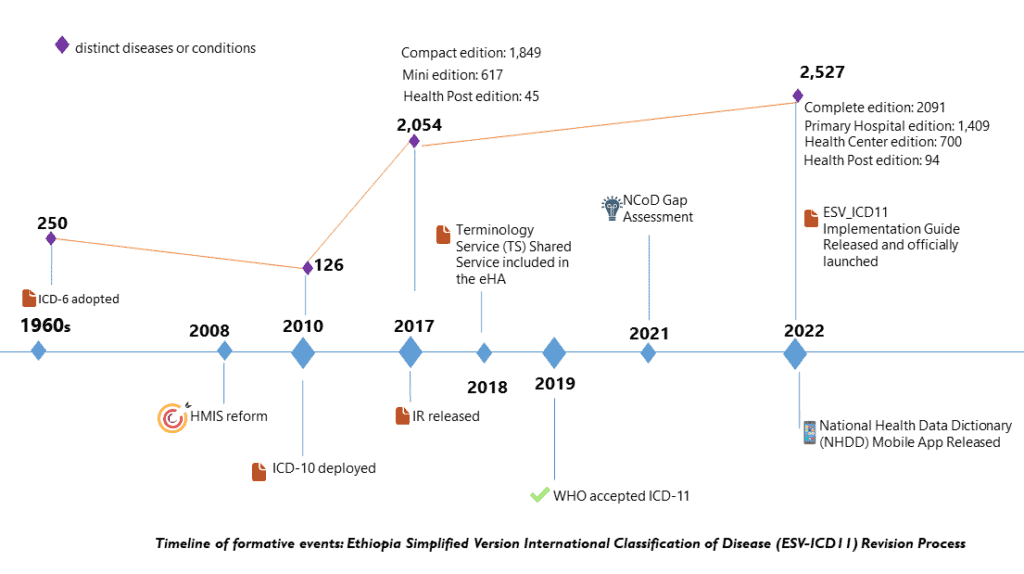The Pathway to Delivering the Simplified Ethiopian Version of ICD-11
July 22nd, 2022 | viewpoint
Attempts to classify diseases started as early as the 1600s. Today, the International Classification of Diseases (ICD) is a standard for diagnostic health information that ensures consistent reporting of diseases and health conditions. A critical tool for epidemiology, health management, research, and clinical purposes, the World Health Assembly (World Health Organization’s decision-making body)-approved ICD is in its eleventh version (ICD-11), which took effect on January 1, 2022.
In Ethiopia, ICD-6 was widely used in the health care system to record and report causes of morbidity and mortality. Following the health management information systems (HMIS) reform in 2008, the Ministry of Health (MOH) defined a new list and coding system with more than 126 diseases and conditions. Each disease entity had a unique serial number mapped to the ICD-10, which was implemented in Ethiopian health facilities from 2009 to 2016.
However, facility users reported several complaints about the HMIS disease code. For facilities with better diagnostic capabilities, the list was too general, while for facilities with limited diagnostic capabilities, it was too specific. In 2017, with the advent of initiatives such as the MOH’s Information Revolution (IR), which is transforming the way health data are generated, managed, shared, and used, the MOH responded by developing the National Classification of Disease (NCoD). Although there were notable changes in disease recording and reporting in both paper and electronic (DHIS2) systems after NCoD implementation, data quality did not improve substantially.

In April 2021, the Ethiopia Data Use Partnership (DUP), a joint initiative between JSI Research & Training Institute, Inc. (JSI) and the MOH to implement the IR, conducted a rapid gap assessment in 51 health facilities. The assessment revealed erroneous use of ICD conventions; redundant diagnoses; missing common diagnoses, such as tetanus and hemorrhoids; code variations from the different ICD editions; lack of standardized implementation guides and operational procedures; inadequate training for health professionals; the need to integrate disease data use with the performance monitoring teams; and absence of a NCoD implementation monitoring mechanism.
Based on the recommendations of the assessment and to better align with the implementation of the Second Health Sector Transformation Plan 2020–2025 (HSTP-II), the MOH planned to overhaul the disease recording and reporting system again. A significant revision would also accommodate epidemiological changes of the past few years (e.g., emerging diseases such as COVID-19) and enable data exchange (diagnosis) between electronic health recording systems. The MOH and implementing partners conducted several consecutive activities in the revision process. A national task force, comprising representatives from different MOH directorates, regional health bureaus, and other data users was established. After a series of consultations and discussions, the task force selected the ICD-11 as the starting point for disease selection.
A total of 294 health professionals (of whom 244 were physicians) from 25 professional categories and specialties were involved in the disease-rating process. The national task force employed the Delphi technique, a well-established approach to answering a research question through consensus across subject experts, to solicit the experts’ opinions. By the end of the process, a refined and contextualized disease list was developed: the Ethiopian Simplified Version – International Classification of Disease (ESV-ICD-11), with five editions (summarized in the table below), including implementation guidelines, standard operation procedures, mobile apps, and job aids.

The MOH in collaboration with implementing partners including DUP, officially launched ESV-ICD-11 on March 18, 2022 in Addis Ababa. The implementation guideline and National Health Data Dictionary mobile apps were also formally rolled out and distributed for use. At the opening of the launch ceremony, MOH Policy, Planning, Monitoring & Evaluation Director Naod Wendrad said, “I therefore, believe that the rollout of the revised disease list, informed by the comprehensive implementation guide, will play an important role in the achievement of our visions and future goals in determining our disease burden and addressing the current and upcoming challenges.”
We strive to build lasting relationships to produce better health outcomes for all.